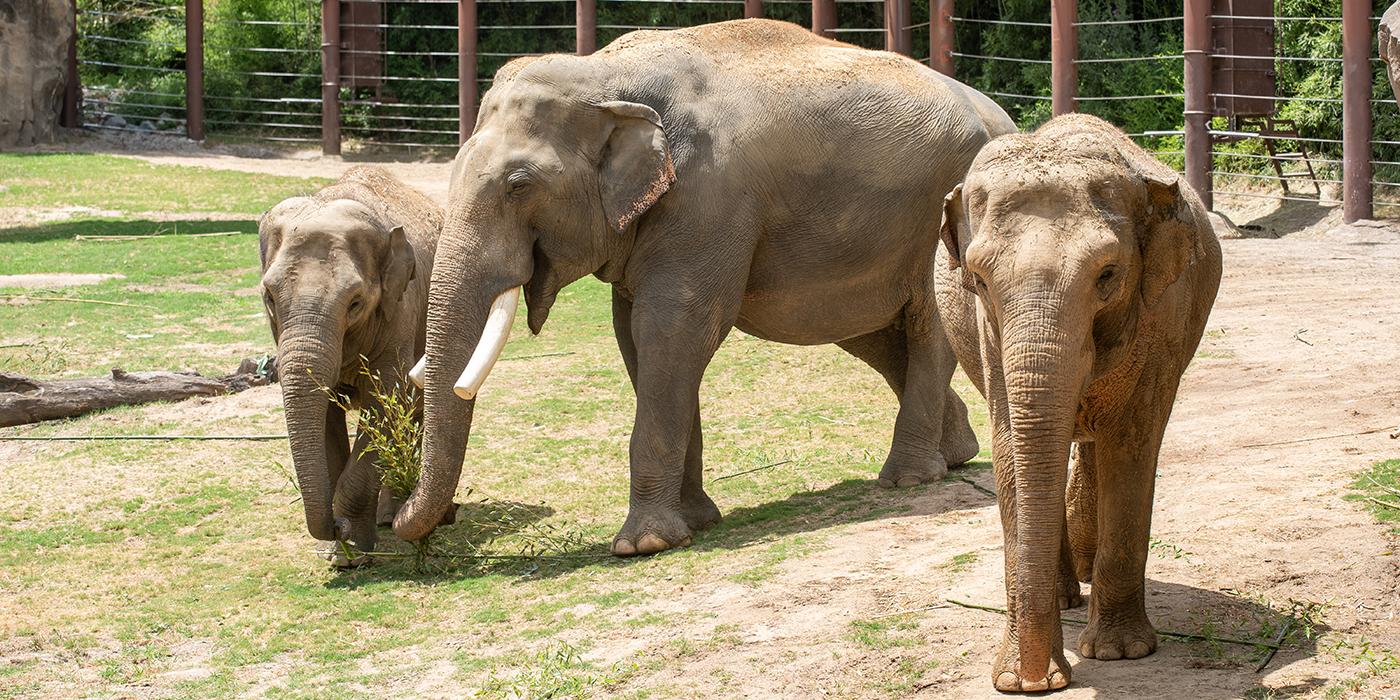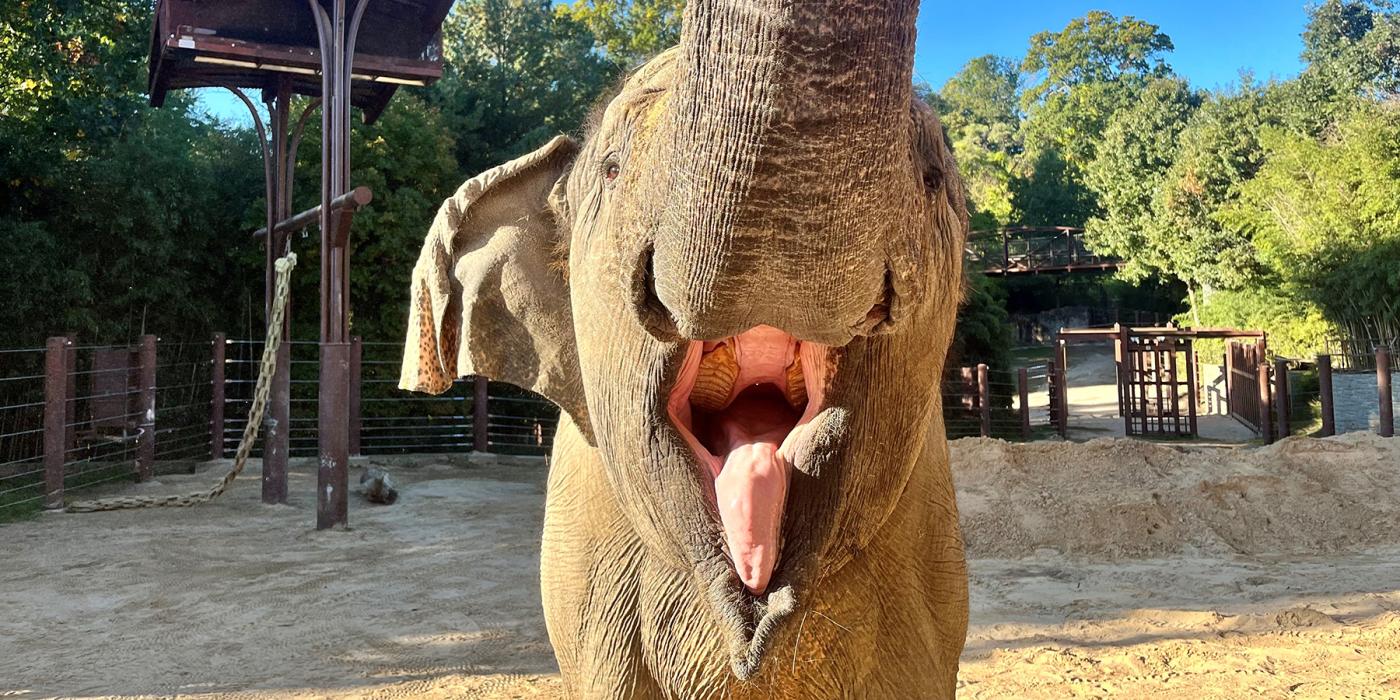Happy Asian Elephant Awareness Month
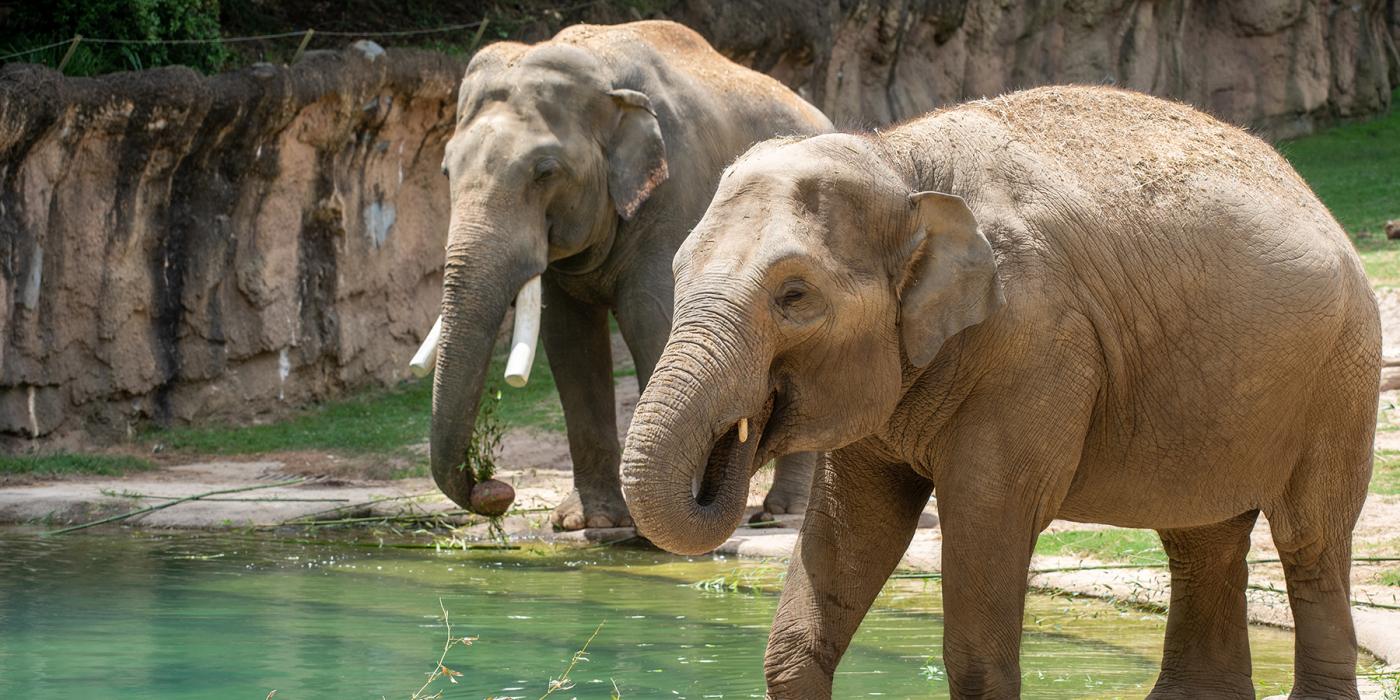
August is Asian Elephant Awareness Month, and we’re celebrating Spike, Bozie, Swarna, Maharani, Kamala, Trong Nhi and Nhi Linh in a BIG way! Follow along as our animal care team shares stories and fun facts about this endearing—and critically endangered—species.
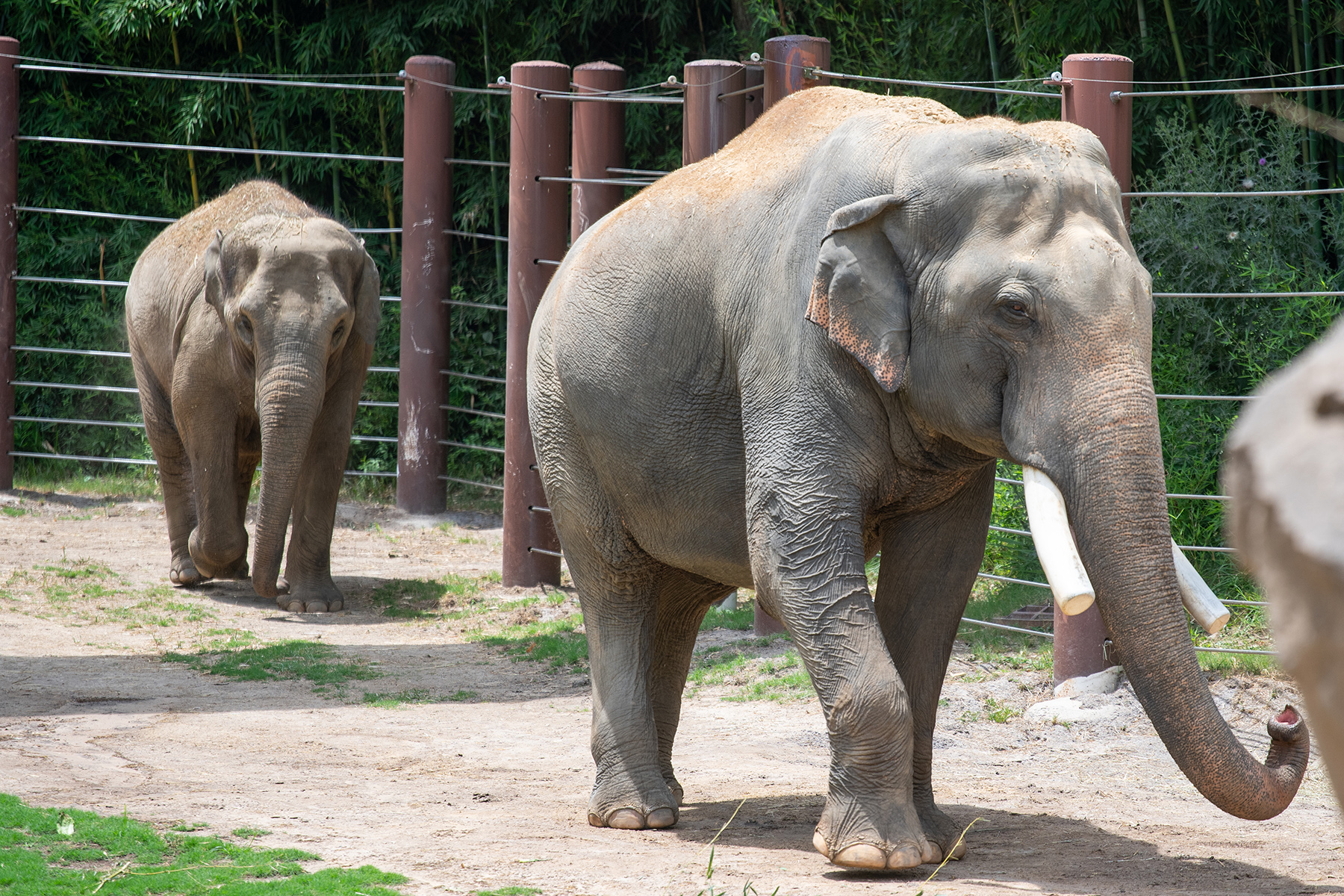
Spike (foreground) and Trong Nhi.
How big do elephants get?
At 13,250 pounds and 10.5 feet tall at the shoulder, our male Asian elephant, Spike, weighs as much as a school bus! (And, he’s the largest animal at the Zoo.) Male Asian elephants are typically larger than females, and this is the case with the Zoo’s herd, too. Our largest female, Maharani, is 8.5 feet tall and weighs 8,565 pounds. Our smallest female—Nhi Linh—is half Spike’s size at 6,437 pounds and stands 7.25 feet tall.
How do keepers know precisely how much the elephants weigh? It takes a unique scale to withstand the weight of a full-grown elephant. In this case, a 10-foot long, 5-foot-wide scale made of steel plates and girders. The scale is built into the base of a protective elephant chute, which keepers have trained the elephants to enter. On a keeper’s cue, Spike will walk onto the scale and stand still while it registers his weight. Keeper Megan Boyd rewards his patience and good participation with a favorite treat: grain!
Weigh-ins can help keepers understand if an animal is feeling OK or has access to too little or too much food. Each animal has a diet designed specifically for their needs so, to keep things balanced, the reward for stepping on the scale often comes directly from their favored items in that diet. Zoo nutritionists can pair weights with visual or hands-on exams to monitor body condition, and to make sure animals are developing normally or maintaining the proper amount of weight.
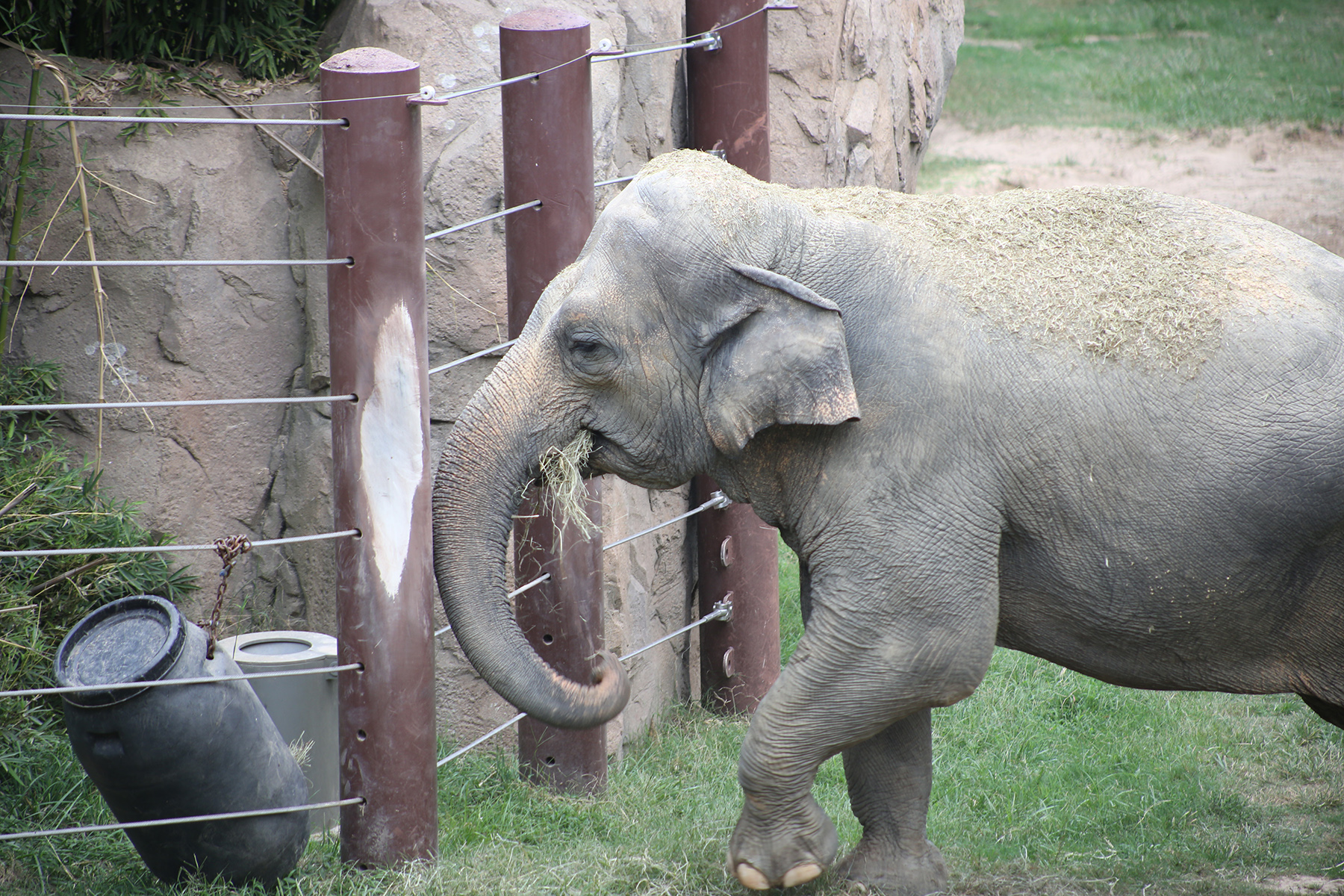
Bozie snacking on hay.
What do elephants eat?
What’s on the menu for the Zoo’s largest animals? Meet Bozie, our female Asian elephant, who eats an impressive 130 pounds of food a day! Her menu includes 1.5 bales of hay, 40 pounds of fresh fruits and veggies, 15 pounds of grain, and 50 to 100 pounds of fresh branches, leaves and bamboo. This varied diet helps Bozie reach 100% of her daily nutritional values. Her wild counterparts typically get only 60 to 75% of these values daily.
Bozie has a sweet tooth for fruits like watermelon and apples. She even enjoys onions! She’s not picky when it comes to food, as long as it’s clean. If one of her treats falls in the sand, keepers risk receiving the side-eye. Bozie likes her food spotless and uses her trunk to wipe treats clean before enjoying them! Elephants have four teeth—each about the size of a brick—with grooves that help them grind vegetation. Keeper Ashley Fortner describes the grooves as looking like a row of fig newtons.
What goes in, must come out! In one day, a single elephant can produce up to 125 pounds of poop and 40 gallons of urine. Luckily, one elephant’s waste is a keeper’s treasure trove. From these samples, our scientists can study hormones, gut microbiomes and more!
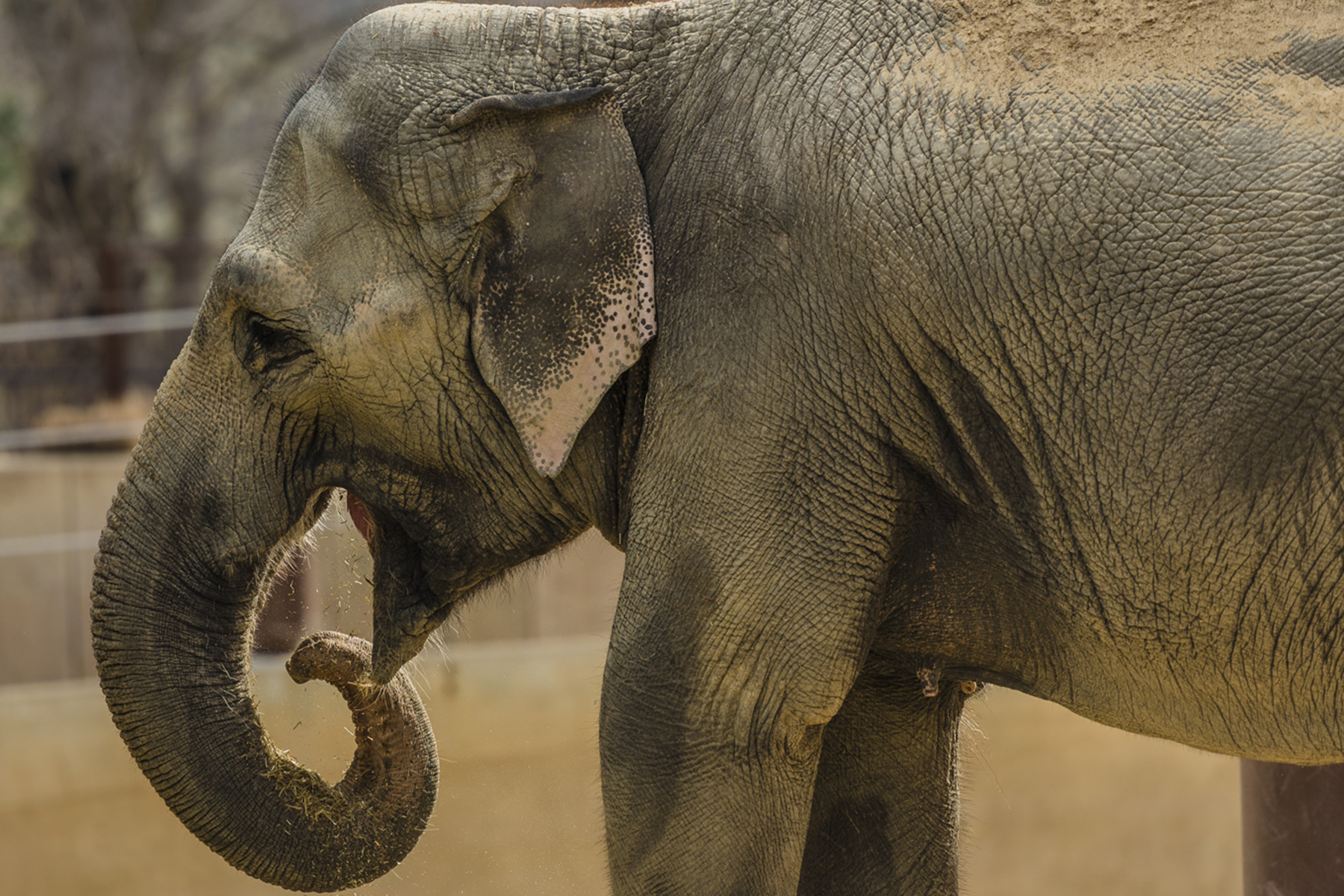
Swarna uses her trunk to bring food to her mouth.
How do elephants use their trunks?
How is an elephant trunk like an accordion? It’s strong, flexible and sometimes musical! More than 100,000 muscles, fibers and tendons make up an elephant’s trunk, outnumbering those found in the human body. Elephants use their trunks for everything, from breathing, eating and drinking to lifting, bathing and much more. It’s a useful communication tool, too, capable of producing everything from quiet, earth-quaking vibrations (called “rumbles”) to blaring trumpet vocalizations.
Asian elephant Swarna is in the middle of our herd’s social hierarchy. She uses her trunk to greet others and show dominance or subordination—it depends on the situation. She may tug on the other elephants’ ears or tails to express dominance. Or, she may place her trunk in another’s mouth to show she accepts their authority. Swarna will also comfort other elephants, particularly Maharani, by using her trunk to draw them closer.
How good is an elephant’s sense of smell? It’s 100 times better than a human’s—so good, in fact, they can even smell water underground and pick up on chemosensory communications, such as hormones and pheromones. And, of course, they use their trunks to sniff out food, including bushes, shrubs and grasses. A single, finger-like appendage at the tip of an Asian elephant’s trunk helps them grab their meal!
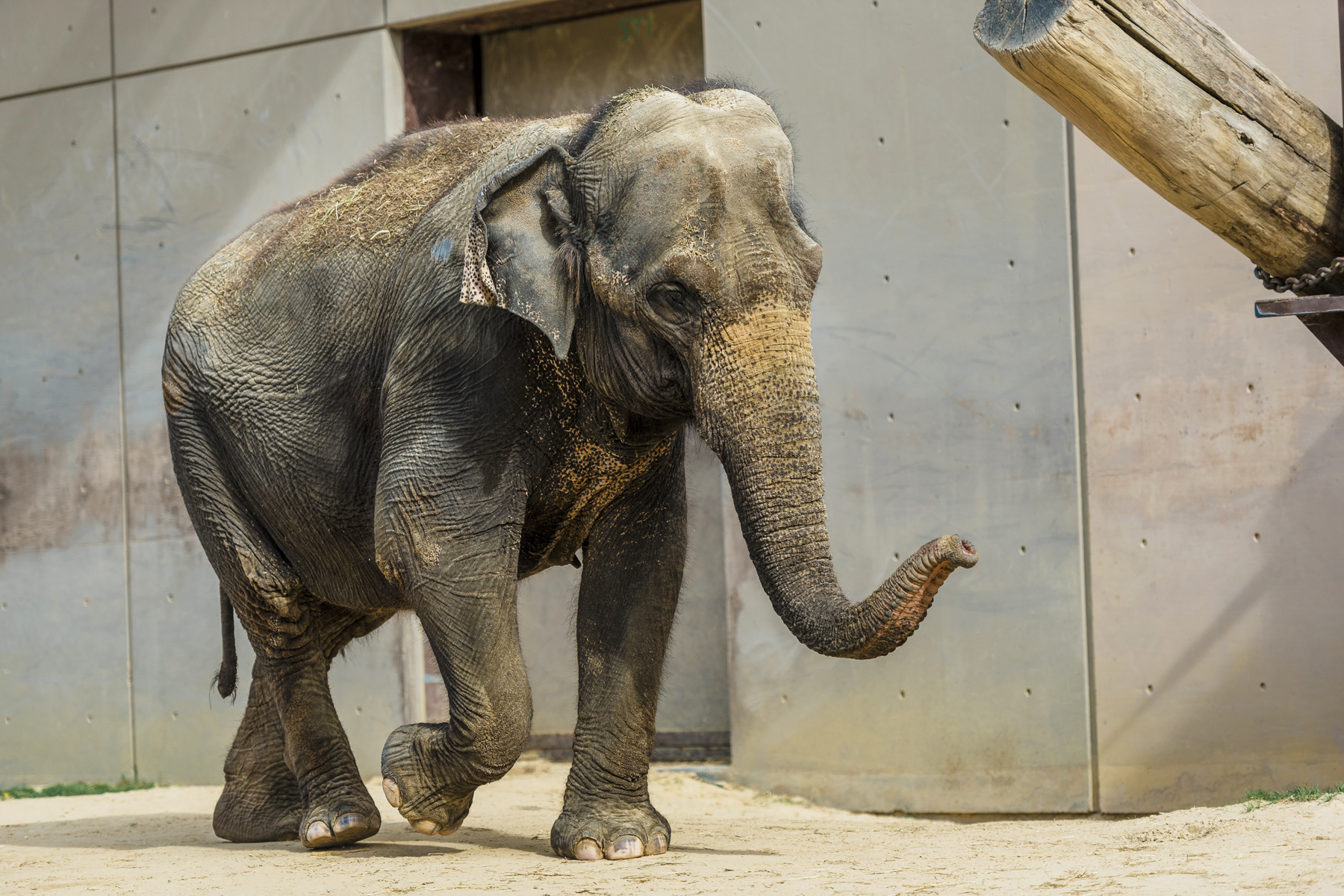
Kamala walks in front of the Elephant Barn.
How do elephants learn?
Watch and learn! Young elephants get their “herd smarts” about where to go, what to eat and what to avoid by observing and mimicking their mothers, aunties and grandmothers. Because she was orphaned as a calf and raised by humans, Asian elephant Kamala—Maharani’s mother—has a slightly different view of the world. She prefers the company of keepers over her herd-mates and is happiest when her caretakers shower her with attention.
Husbandry training sessions—which offer quality one-on-one time with keepers—are the highlight of Kamala’s day, says keeper Matt Chambers. Elephants masterfully maneuver through their environment thanks to their big brains, which typically weigh between 9 and 13 pounds. (That’s three-to-four times larger than a human brain!) Kamala uses her smarts to interpret Matt’s words and body language—called “cues”—and do the corresponding action. Her enthusiastic participation in her own care allows the elephant team to examine her up close and keep track of her health and well-being.

Maharani explores the Elephant Trails outdoor habitat.
How do elephants move around?
Don’t be fooled by Asian elephants’ size and stature—these gentle giants can be super sneaky. The secret lies in the pads of their feet, which muffle the sounds of snapping twigs or branches. They are amazingly agile. Not only can they stand on any two legs, but also they can walk across a beam that is narrower than their foot. And, they do all of these movements on tiptoe!
Although Maharani *can* move silently, one of her favorite activities is getting a social party started! Racing across the habitat at top speed (around 20 miles per hour), she kicks up sand, flings toys around and lets out a medley of trumpet blasts that can be long or short in measure and high or low in tone. Keeper Debbie Flinkman affectionally says these vocalizations sound a bit like an elementary school band warming up. Often, Maharani gets her herd-mates to join in the ele-FUN!
Can elephants jump? Unfortunately, no. Their legs lack the springy joints and muscles needed to physically push all four feet off the ground at the same time. But they can go up and down steep hills with ease, thanks to grooves in their foot pads that provide traction. An elephant’s toenails can dig into the ground, too, giving them extra leverage. The Zoo’s elephants often use their feet to dig up and manipulate enrichment items, from giant tree trunks and tires to smaller puzzle feeders. In any given situation, elephants must determine whether to use their brute strength or delicate dexterity.
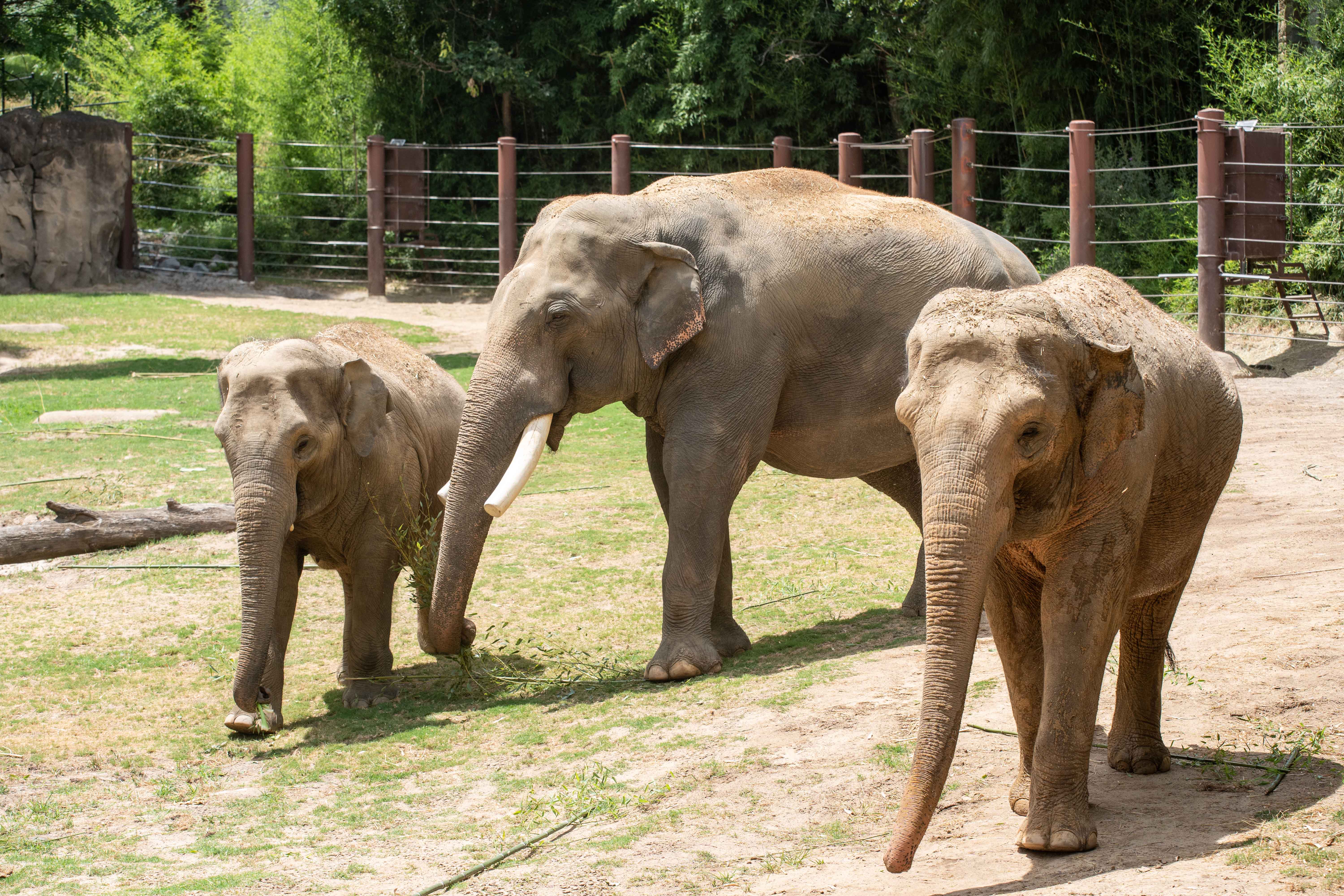
Asian elephants Nhi Linh (left), Spike (middle) and Trong Nhi (right) forage for bamboo.
Who is the head of an elephant herd?
We are family! Asian elephant herds are led by a matriarch—typically, the oldest female—and are made up of related females and their young. As the head of the family, the matriarch makes all of the important decisions and acts as the peacemaker. Along with their mothers and aunties, she teaches the youngsters how to survive. Many of the behaviors elephants use to navigate the world aren’t innate; rather, they are learned by watching and interacting with these motherly figures.
When Trong Nhi and her daughter Nhi Linh first arrived at the Zoo in November 2022, she was a bit of a “helicopter parent.” She tended to be cautious and protective of Nhi Linh, who was eager to explore and meet our tall, gray and handsome bull, Spike. Over a year and a half of introductions, Trong Nhi has grown more confident and comfortable with letting Nhi Linh spend time alone with Spike. Keeper Rebecca Riley says it has been very rewarding to see the trust and bonds among the trio grow.
Watching the Zoo’s herd is an amazing reminder of the deep connections these animals can form with each other. Elephants show empathy and cooperation in ways that remind us of ourselves. They support each other through big events (such as giving birth and raising calves), they protect each other from danger, and when a herd member dies, they come together to mourn.
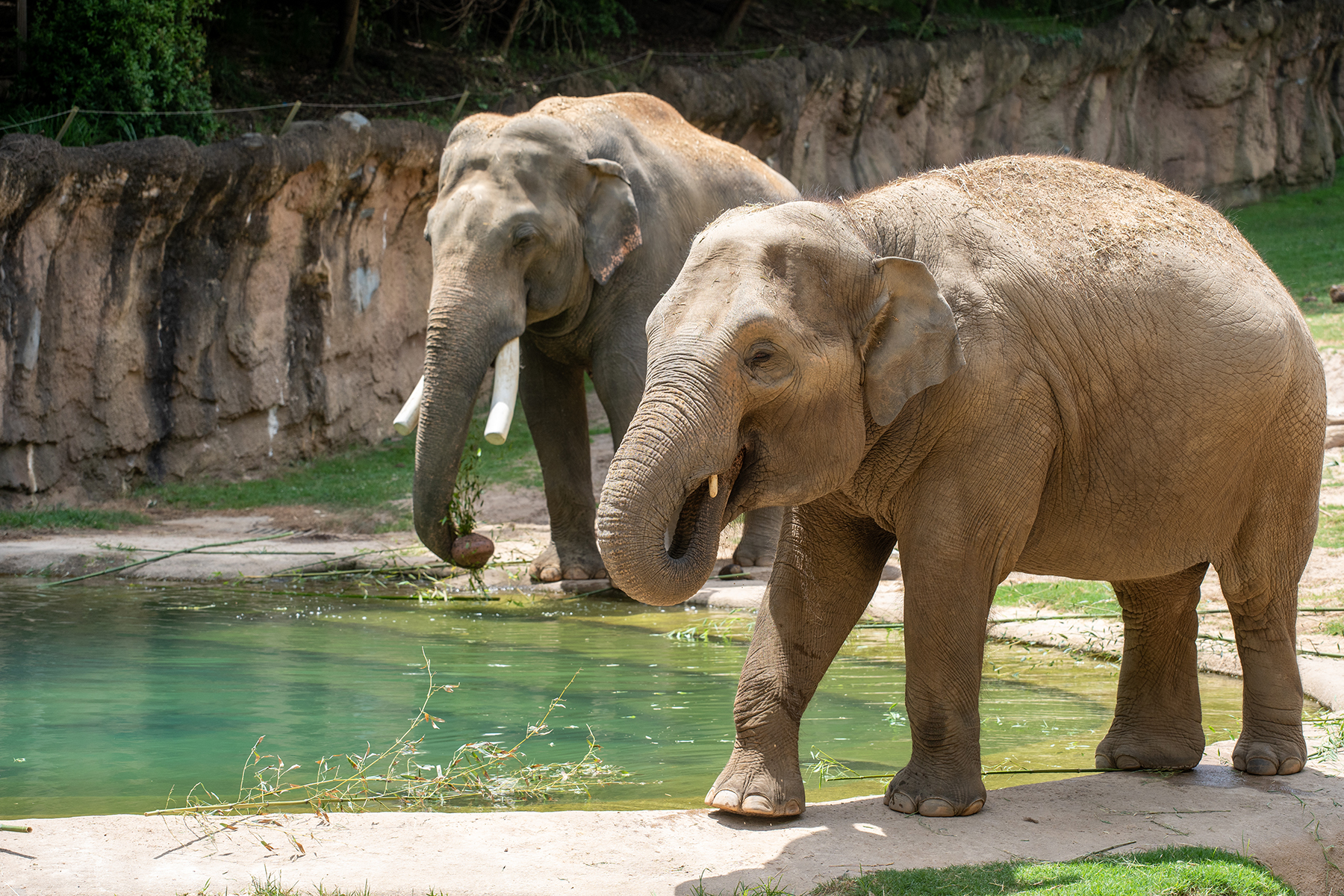
Nhi Linh (foreground) and Spike stand along the edge of the Elephant Trails outdoor pool.
Why do elephants throw dirt on their backs?
With visible wrinkles in their skin, you probably wouldn’t think to ask an Asian elephant like Nhi Linh what her skincare regimen is. But all of those folds and cracks serve a purpose. They help her retain ten times more moisture than skin that is smooth and taut!
Asian elephants have hair all over their bodies, though it tends to be short and course, like the treads on a tire. It offers little to no protection from the sun. And they can’t sweat to cool down—the only place they have sweat glands is in between their toes. So, elephants gather “sunscreen”—a mixture of sand, dirt and hay—with their trunk and toss it onto their back to keep cool, prevent sunburn and ward off biting insects.
Young elephants learn this behavior, called “sand-dusting,” by watching older members of their herd. Some elephants apply this sunscreen more diligently than others, says keeper Amanda Bobyack. To encourage our elephants to sand-dust, keepers give them baths with soapy water and exfoliate their skin with a large bristle brush. As they air-dry, their skin becomes itchy, prompting them to re-apply the soothing sunscreen.
Perhaps the most urgent threat to wild Asian elephants is a recent and troubling rise in poaching for their skin and meat. Males, females and calves are all equal targets, and it's driving down populations. In elephant range countries like Myanmar, our scientists place GPS tracking collars on elephants to better understand where they live and where they are susceptible to poachers. They share that information with non-governmental organizations and local community members to try to save elephants from extinction.
Looking for more fun facts? Learn how our animal care team trims Spike’s tusks, helped Swarna when she had a toothache, and obtain our elephants’ weights! Visiting the Zoo? Catch elephant keeper talks every day at 3 p.m.
Related Species:

